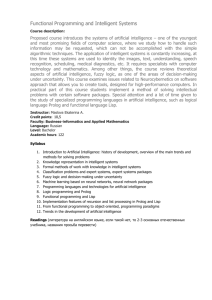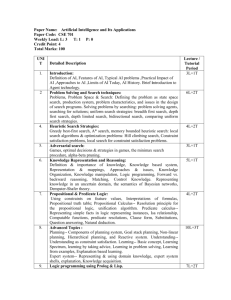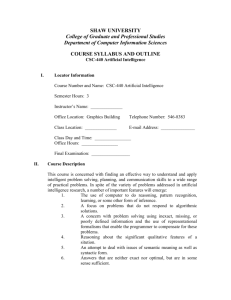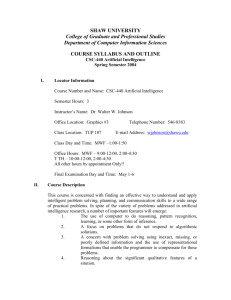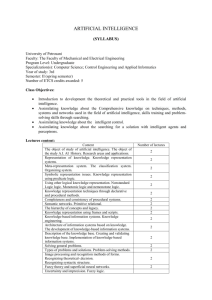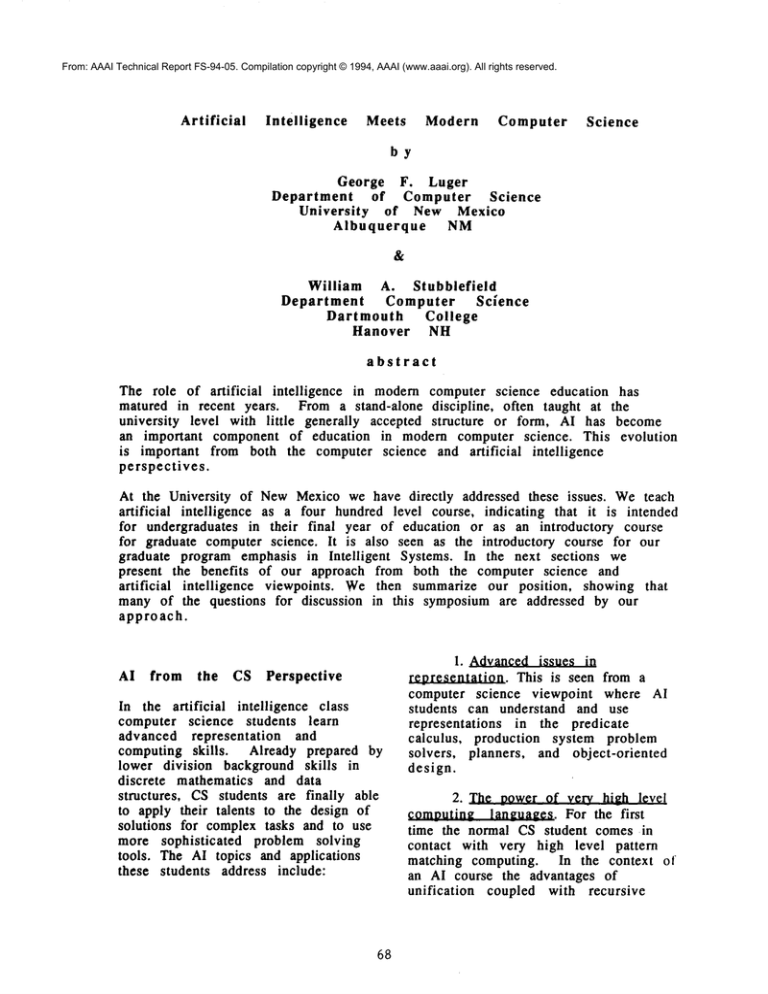
From: AAAI Technical Report FS-94-05. Compilation copyright © 1994, AAAI (www.aaai.org). All rights reserved.
Artificial
Intelligence
Meets
Modern
Computer
Science
by
George F. Luger
Department
of Computer
Science
University
of New Mexico
Albuquerque
NM
&
William A. Stubblefield
Department
Computer
Science
Dartmouth
College
Hanover
NH
abstract
The role of artificial
intelligence
in modemcomputer science education has
matured in recent years. From a stand-alone discipline,
often taught at the
university level with little
generally accepted structure
or form, AI has become
an important component of education in modem computer science.
This evolution
is important from both the computer science and artificial
intelligence
perspectives.
At the University of New Mexico we have directly addressed these issues. We teach
artificial
intelligence
as a four hundred level course, indicating that it is intended
for undergraduates in their final year of education or as an introductory
course
for graduate computer science. It is also seen as the introductory course for our
graduate program emphasis in Intelligent
Systems. In the next sections we
present the benefits of our approach from both the computer science and
artificial
intelligence
viewpoints. We then summarize our position,
showing that
many of the questions for discussion in this symposium are addressed by our
approach.
AI from the
CS Perspective
In the artificial
intelligence class
computer science students learn
advanced representation
and
computing skills.
Already prepared by
lower division background skills in
discrete mathematics and data
structures,
CS students are finally able
to apply their talents to the design of
solutions for complex tasks and to use
more sophisticated
problem solving
tools. The AI topics and applications
these students address include:
68
1. Advanced issues in
representation.
This is seen from a
computer science viewpoint where AI
students can understand and use
representations
in the predicate
calculus,
production system problem
solvers, planners, and object-oriented
design.
2. The power of Very high lev~i
comoutin~r languages. For the first
time the normal CS student comes in
contact with very high level pattern
matching computing. In the context of
an AI course the advantages of
unification
coupled with recursive
search algorithms
demonstrated.
can be clearly
3. Language experience,
including C++ and CommonLisp.
3. The design and use of metalinterpreters.
This very important byproduct of high level language tools
offers important insights
for computer
science students.
We design production
rule interpreters,
semantic net
inheritance
algorithms,
and
interpreters
for an object based
representation.
4. Other related AI topics. These
including the control of complexity
issues with heuristics,
the design of
context free and context dependent
parsers and generators for natural
language. Also presented are methods
for reasoning with uncertainty
and an
introduction
to machine learning.
These are important issues INTRODUCED
in the context of a first level AI class.
The
AI Perspective
Because introductory
AI students come
from a background of computer
science we find that many of the
computational skills missing in AI
classes a decade ago are already
present when they begin the AI
course. These skills come primarily
from the courses in discrete
mathematics and data structures.
Our
students have already had (at least)two
courses using C++ and a general
language course where they learned
rudimentary skills
in CommonLisp
programming. Granted, they don’t yet
have the skills to use very high level
languages properly.
The skills
include.
they bring to the AI class
1. Extensive
knowled2e of ~raDh
theory.
2. Experience
data structures.
with recursive
69
4. Preliminary
predicate calculus,
knowledge of the
These skills allow us to begin AI
instruction
at a fairly advanced level
and get rather quickly into interesting
topics. We present these more
sophisticated
AI topics as the "leading
edge" of tools for contemporary
computing. These are the tools that
modern engineers must bring to their
problem solving tasks for government,
industry, and further education.
The topics covered in an introductory
AI class include those tools needed for
getting into more current issues in AI.
The techniques
presented in an
introductory class allow for the design
of advanced representational
schemes
and search algorithms that support
research areas including theorem
proving, natural language
understanding,
and machine learning.
These are the topics of our advanced
course offerings in AI. After an
introductory
course students are also
prepared for the design and building
of more sophisticated
rectainterpreters
in high level languages.
Symposium
Issues
Our approach to education in AI allows
for tentative
answers to some of the
important issues of this symposium.
1. We have a coherent
introduction to the key issues of AI. Far
from the " AI smorgasbord" approach,
we introduce and interrelate
issues in
the context of modern topics and tools
for computing. In this sense our
product is not "disjointed or
superficial."
As the curriculum
presented below indicates,
AI topics
form a cohesive and organic flow
rooted in the supporting concepts of
sound computer science.
2. There is no confusion between
cognitive science and artificial
The different and
diverging goals of these two disciplines
are emphasized from the first class. We
have a cognitive science course for
those students desiring to acquire this
knowledge. Where cognitive
science
and AI come close, in the use of such
tools as the production system for
¯ example, these parallels are pointed
out.
Our ideas for introductory
education in
AI are exemplified in the brief
curriculum description
that follows.
They may be seen in detail in our book
from Benjamin Cummings (1993):
Artificial
Intelligence:
Structures and
Strategies
for Complex Problem
Solving.
3. There is an integration of
multiple AI "viewpoints,"
The context
of "engineering solutions"
actually
offers a nice coming together of
sometimes disparate AI views. It is
only in the presentation
of advanced
issues in later AI courses that these
views are seen as creating the future
for research in AI.
An
Curriculum
Introduction
to
Textbook (L&S, for reference
in the following descriptions):
Artificial
Structures
Complex
Intelligence:
and Strategies
Problem Solving
by
George F. Luger &
William A. Stubblefield
Benjamin
Cummings,
1993
An important topic not addressed by
this symposium is the role of practice
and research in AI within the larger
university
curriculum.
Certainly the
task of understanding
and building
intelligent artifacts relates to the
issues of the disciplines
of psychology,
philosophy (including
ethics),
and
education, to mention but a few. This
important issue must be part of any
coherent teaching of AI, but as a topic
it is left to future AI symposia.
Description:
Artificial
Intelligence
purposes
The predicate calculus: syntax &
semantics
Inference: soundness,
completeness
The unification
algorithm
for
Week 4: Structures
and Strategies
for
State Svace Search (L&S ch 3)
¯
Quick review of graphs
¯
State space search
¯
Data driven and goal driven
search
¯
Breadth first, depth first, depth
first iterative
deepening search
Week 1: Artificial
Intelli2ence.
Its
Roots and Scope (L&S, chl, Intro Pt II)
¯
AI, an attempted definition
¯
Historical
foundations
¯
Overview of application
areas
¯
An introduction to
representation
and search
Weeks S & 6: Heuristic
Search
(L&S,
ch 4).
¯
¯
Weeks 2 & 3: The Predicate
Calculus
(L&S, ch2)
¯
Representation
languages
¯
The propositional
calculus and
its semantics
¯
¯
¯
¯
70
Priority
queues
A*, admissibility,
monotonicity,
and informedness
Iterative
deepening A*
Beam search
Two-person
games
Mini-Max and alpha-beta
Weeks 7 & 8: Architectures
for AI
Problem Solving (L&S, ch5)
¯
Recursive specification
for
queues, stacks, and priority
queues
¯
The production system
¯
The blackboard
¯
Planning and Triangle Tables
Week 15: Course Summary and Review
(L&S, ch 16)
¯
Video demonstrations of object
based and hybrid design
¯
The possibility of a science of
intelligence
¯
Future research issues and
limitations
of the AI paradigm
Weeks 9 & 10: PROLOG
¯
The PROLOGenvironment
¯
Relational specifications
and
rule based constraints
¯
Abstract data types in PROLOG
¯
Graph search with the
production
system
¯
A PROLOGplanner
The course includes two examinations,
a mid-term and a final,
each one hour
long.
There are three programming
assignments:
1. Building graph search
algorithms in PROLOG:
a) depth first
b) breadth first
c) best search
2. Building graph search
algorithms in LISP:
a) depth first
b) breadth first
c) best search
3. Using EXSHELL
to build a rule
based expert reasoning system
Course credit: Mid-term and final 40%
each, programming assignments
20%
Weeks 11 & 12: The Rule Based Exvert
System (L&S, ch 8)
¯
Production system based search
¯
Rule stacks and "why" queries,
proof trees and "how" queries
¯
Models of inductive reasoning
¯
The Stanford Certainty Factor
algebra
¯
Knowledge engineering
¯
Tieresias,
a knowledge based
editor
Week 13: Building a Rule Based Expert
System in PROLOG(L&S, ch 13)
¯
Meta-predicates
in PROLOG
¯
The role of a meta-interpreter:
PROLOGin PROLOG
¯
Rule-stacks, proof-trees,
and
certainty factor algebras in
PROLOG
¯
Exshell, a back-chaining rule
interpreter
in PROLOG
More detail for teaching this course,
including a complete set of lecture
notes and programs may be obtained
from Benjamin Cummings, 390 Bridge
Parkway, Redwood City CA, 94065.
Request the Instructor’s
Manual that
accompanies the text. All our programs
are available using anonymous ftp:
Week 14: Introduction
of Structured
AI Representational
Schemes (L&S, ch
see the lisp and prolog subdirectories
under ~pub/ai
ftp ftp.cs.unm.edu
9)
¯
¯
¯
¯
¯
Issues in knowledge
representation
Semantic networks
Conceptual dependencies
Frames, scripts, and object
systems
The hybrid design: objects
rule sets
Introductory
Materials
AI
Curriculum
We have two offerings for the Type III
submission. First, a complete set of
video tapes for an introductory
AI
with
71
course and second, a complete set of
programs in PROLOGand Common Lisp.
2.4 A STRIPS-like planner. This is
demonstrated in the blocks world.
2.5 A rule based shell, able to process
how and why queries. It uses the
standard Stanford certainty
factor
algebra. A sample knowledge base is
provided.
1. The set of 32 video lectures. These
tapes were developed with professional
camera and editing techniques of the
Instructional
Television Group at the
University
of New Mexico. They cover
in detail the lectures that make up a
one quarter/semester
course in AI.
Complete descriptions
of these tapes
and what they cover are available for
the University
of New Mexico (contact
the first author: luger@cs.unm.edu).
2.6 Semantic net and frame-based
inheritance
search (PROLOGand Lisp.
2. A complete set of programs in
CommonLisp and PROLOGare available
for both an introductory
and advanced
course in AI. Here we list the topics for
which running programs with
exaqmples are available.
The code is
may be obtained from ftp
ftp.cs.unm.edu
in subdirectory
~pub/ai.
2.7 The creation of an object-oriented
meta-interpreter.
This is built, step by
step, in both PROLOGand CommonLisp.
We feel this is an important tool for
seeing the power of very high level
languages in building more
sophisticated
representational
schemes.
2.8 The creation of a hybrid
environment by attaching
rule sets
the object oriented representations
2.7.
2.9 Demonstration and justification
the main CLOSbuilt-in
predicates.
2.1 Implementation
of introductory
Data Structures: sets, bags, stacks,
priority queues, etc.
2.2 Control algorithms for search:
depth-first,
breadth-first,
best-first.
We present these search algorithms as
"shells" where the user may add the
rules for search of a particular
problem domain. Several examples are
demonstrated.
to
of
of
2.10 The demonstration
of a number
of machine learning algorithms:
a. Version space search, specific
to general, general to specific, and
candidate elimination
(PROLOGonly).
b. Explanation based learning
(PROLOG)
c. ID3 (Common Lisp)
2.11 The .creation
and demonstration
of context free, context sensitive, and
recursive
descent semantic net parsers
(PROLOGonly).
2.3 A general control strategy for a
production system. This is
demonstrated with several problem
domains.
72

